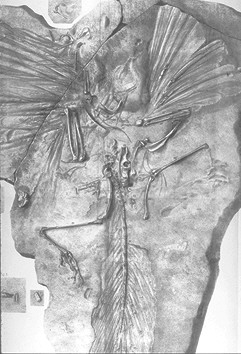14. The First Archaeopteryx, 1863
 The
first fossil of Archaeopteryx lithographica was found in the
limestone quarries of Solnhofen in 1861. It was described and named by the
German paleontologist Hermann von Meyer, but the fossil was owned by a
local physician, Karl Haberlein, who was determined to sell it to the
highest bidder. That happened to be the British Museum, whose trustees
were persuaded by Richard Owen to part with the considerable sum of 700
pounds to purchase the specimen.
The
first fossil of Archaeopteryx lithographica was found in the
limestone quarries of Solnhofen in 1861. It was described and named by the
German paleontologist Hermann von Meyer, but the fossil was owned by a
local physician, Karl Haberlein, who was determined to sell it to the
highest bidder. That happened to be the British Museum, whose trustees
were persuaded by Richard Owen to part with the considerable sum of 700
pounds to purchase the specimen.
Owen published his own description of Archaeopteryx in 1863, accompanying his memoir with a life-size double folding lithograph. It shows the details of the specimen in extraordinary detail. The London specimen, as it is now called, lacks a head, but it contains exquisite impressions of feathers, and appears to even the casual observer to be quite bird-like. Yet it could equally well be called a dinosaur, a Compsognathus with feathers, with its long bony tail and with three fingers with claws on each wing. To Owen, however, who was an anti-evolutionist and very much opposed to the idea of missing links, Archaeopteryx was unequivocally a bird--a peculiar and distinctive bird, but a bird nevertheless.
For a detail of this lithograph, click here.
 Source:
Source:Owen, Richard. "On the Archeopteryx of von Meyer, with a decription of the Fossil Remains of a Long-tailed species, from the Lithographic Stone of Solenhofen," in: Philosophical Transactions of the Royal Society of London, vol. 153 (1863), pp. 33-47. This work is on display as exhibit item 14.


 ®Linda Hall Library
®Linda Hall Library5109 Cherry Street
Kansas City, MO 64110
Please direct comments to ashwortb@lhl.lib.mo.us